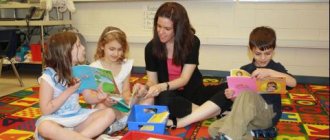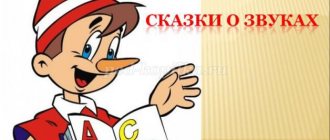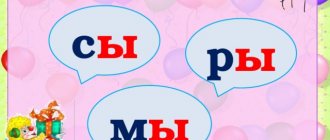Summary of a lesson in kindergarten on teaching literacy in the senior group
Summary of a literacy lesson on the topic “Forest”.
Senior group Description of the material: I offer you a summary of direct educational activities in the senior group (5-6 years old) on the topic “Forest”. This material will be useful for preschool teachers of older groups. This lesson summary is aimed at developing the ability to conduct sound analysis of words and graphically record sentences. Integration of educational areas: “Cognition”, “Communication”, “Socialization”. Program objectives: 1. To develop the ability to conduct sound analysis of words; 2. To develop the ability to graphically record a sentence; 3. Develop and improve children’s phonemic hearing; 4. Expand children’s ideas about the world around them; 5. Foster a caring attitude towards nature. Equipment: forest illustration; subject pictures of animals; chips; word schemes; 2 houses with pockets; graphical diagram of the proposal; hoops Vocabulary work: fox. Preliminary work: examination of illustrations depicting wild and domestic animals.
Course of the lesson
1. Organizational moment Educator: Today we have guests, let's introduce ourselves to them. Each of you will say your name and highlight the first sound that your name begins with. 2. Statement of the topic and purpose of the lesson Educator: What is the name of our lesson? What do we do in literacy? Do we need literacy in life? For what? Educator: Today we will play and do various exercises, you will receive chips for your work, and at the end you will count how much you earned. 3. Phonetic exercise – Listen to music. (Forest music sounds)
- Where can all these sounds be heard?
What is a forest? (Show illustration)
.
- Who lives in the forest? What can you hear in the forest? Let's remember forest sounds and designate them with chips. How does a strong wind blow? – What chip do we use to denote sound? How do the leaves on the trees rustle? – How do beetles buzz? (Zh-zh-zh)
– How do small mosquitoes ring?
(Z-z-z) 4. Sound analysis of the word “fox” Educator: Now listen to a riddle about one forest dweller: A cunning cheat, Red head, Fluffy tail - beauty, Who is it? (Fox.
)
Educator: Let's divide the word “fox” into syllables. How many syllables? (2) Educator: Let's say the word. Which syllable is pronounced with more force? Name the first syllable. – What was the first sound you heard? Let's denote it with a chip. Children lay out a diagram of the word “fox”. Educator: How many sounds are there in total? How many vowels are there in total? Do you agree? 5. Physical education for the eyes 6. Graphic recording of a sentence Educator : Let’s make a sentence about a fox and write it down using a diagram. (Children offer various options and write down sentence patterns). Educator: Who is this fox? What animal is this? Why? What other wild animals do you know? 7. Didactic game “What is this?” Educator: In the forest it can be green. What is this? (Leaves, grass, grasshopper, frog, spruce.) Educator: It can be long in the forest. What is this? (Snake, caterpillar, forest path.) Educator : In the forest it can be fast. What is this? (Hare, bird, squirrel.) Educator : In the forest it can be dangerous. What is this? (Snake, bear, poisonous mushrooms.) 8. Physical education lesson Teacher: Let’s play and relax in a forest clearing. The game is called "Make no mistake." Now music will sound, and you must run to the music around hoops in which there are pictures with animals. If the animal depicted in the picture lives in the forest, you run into the hoop at the end of the music, if not, then you are eliminated from the game. (Play 2 times) (Pictures of wild and domestic animals). 9. Game “Find a house for an animal” Educator: You know that many wild animals live in the forest. Let's play the game "Find a house for an animal." (Visibility of 2 houses: with one and two pocket windows)
.
If the animal's name has one syllable, then we move it into a house with one window; if it has two syllables, then into a house with two windows. Pictures: mouse, wolf, bear, fox, squirrel. 10. Summary of the lesson
Educator: What did we do today? What did you like most? What did you do well? What was causing the difficulty? Count how many chips each of you has? Well done!
We recommend watching:
Notes on educational activities in the senior group "Northern Adventures" Notes on a lesson on preparing children 5-6 years old for school Notes on the final lesson on teaching literacy in the senior group Notes on lessons on teaching literacy in the senior group. Sounds G, Gy. Letter G
Similar articles:
Summary of a mathematics lesson in the senior group of kindergarten. Geometric figures
Bibliography
1. Varentsova N.S. Some problems of a teacher's work on the development of mental abilities in preschool children. - In the book. Educational work in kindergarten under the “Development” program. Methodological manual for preschool teachers / Ed. Dyachenko O. M., Kholmovskoy V. V., -M.: Gnom i D, 2001.
2. Varentsova N.S. Continuity in the education of children of preschool and primary school age // Preschooler. Junior schoolboy, 2003 - No. 4.
3. Questions of psychology of educational activities of junior schoolchildren / Ed. D. B. Elkonina, V. V. Davydova. -M.: APN RSFSR, 1962.
4. Preparing the hand for writing // Preschool education, 1996, No. 2.
5. Diploma for preschoolers. - In the book. Children, get ready for school - M.: Education, 2008.
6. Durova N.V., Nevskaya L.N. Teaching preschoolers literacy. Didactic materials in four books, - Part 4 (We read it ourselves). - M.: School press, 2001.
7. Zhurova L.E. Teaching literacy in kindergarten. -M.: Education, 1974.
8. Getting to know the “Development” program: A manual for educators and parents / Ed. O. M. Dyachenko. -M.: New School, 1997.
9. Pedagogical diagnostics according to the “Development” program. Recommendations and materials for implementation. Junior and middle preschool age, -M.: Gnom-Press, 1999.
10. Pedagogical diagnostics according to the “Development” program. Recommendations and materials for implementation. Senior preschool age, - M.: Gnom-Press, 1999.
11. Lesson plans for the “Development” program for the younger group of kindergarten. – UC named after. L.A. Wenger "Development". -M., 2000.
12. Lesson plans for the “Development” program for the younger group of kindergarten. – UC named after. L.A. Wenger "Development". -M., 2000.
13. Lesson plans for the “Development” program for the preparatory group of kindergarten. – UC named after. L.A. Wenger "Development". -M., 2000.
14. Lesson plans for the “Development” program for the middle group of kindergarten, – UC named after. L.A. Wenger “Development”, M., 2000.
15. Lesson plans for the “Development” program for the senior group of kindergarten. – UC named after. L. A. Wenger “Development”. -M., 2000.
16. Preparation for teaching literacy in kindergarten / Ed. N.S. Varentsova, N.S. Starzhinskaya. – Minsk: Nar. Asveta, 1992.
17. Preparation for teaching literacy to five-year-old children. Guidelines. – Minsk: MP of the BSSR, 1986.
18. Speech development. - In the book. Diary of a teacher: development of preschool children / Ed. O. M. Dyachenko, T. V. Lavrentieva. Vol. 1, 2, -M.: Series “Psychology of Education”, MOiPK, 1996.
19. Development: New generation program for preschool educational institutions. Junior group / Ed. O. M. Dyachenko.-M.: Gnom-Press, 1999.
20. Development: New generation program for preschool educational institutions. Middle group / Ed. O. M. Dyachenko.-M.: Gnom-Press, 1999.
21. Development: New generation program for preschool educational institutions. Senior group / Ed. O. M. Dyachenko.-M.: Gnom-Press, 1999.
22. Development: New generation program for preschool educational institutions. Preparatory group / Ed. O. M. Dyachenko, M.: Gnom-Press, 1999.
23. Rogovin A. I want to do it myself, - M.: Pedagogy, 1984.
24. Fedosova N. A. Getting ready to write. – Part 1, 2, -M.: Gnom i D, 2004.
25. Reading and writing according to the system of D. B. Elkonin. Book for teachers, M.: Education, 1993.
26. Shuleshko E.E. Teaching writing and reading. Methodological manual for kindergarten teachers. – M., 1998.
27. Elkonin D.B. How to teach children to read. Abstract information. Preschool education. -M., 1977, -No. 4.






